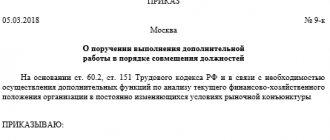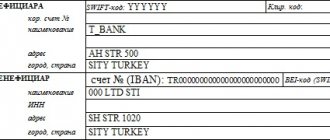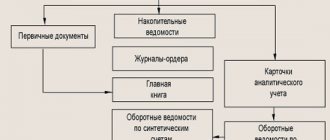What it is?
The possibility of dismissal by transfer is established by Art. 72.1 Labor Code of the Russian Federation. The translation can be internal or external. There are three parties involved in such a legal procedure: the employee himself, as well as the current and new employer.
During an external transfer, the employee leaves his current place of work and is transferred to another organization. At the same time, he signs a corresponding employment contract (agreement) with the new employer. During an internal transfer, only the employee’s responsibilities change or he is moved to another workplace within his organization.
An external transfer always involves reaching an agreement between the previous and new employers and the employee himself. Variants of such an agreement may vary.
- For example, in such a situation, a tripartite agreement is drawn up or letters are exchanged.
- Then, information about his dismissal is entered into the work book of the dismissed person on the basis of clause 5, part 1, art. 77 Labor Code of the Russian Federation.
- When hired by another organization, a separate entry is made in this document stating that the employee was hired as a transfer.
It is prohibited to transfer or relocate an employee to a job that is contraindicated for him due to health reasons (Article 72.1 of the Labor Code of the Russian Federation).
How is it different from calculation at one’s own request, by agreement of the parties or on the initiative of the employer, and what is better?
There is a significant difference between voluntary dismissal and transfer to another organization. So, if in the first case the dismissed employee can withdraw his application at any time, then in the second situation he can no longer do this.
In addition, the legal basis for transfer to another organization is not only the application of the dismissed person, but also the personal interest of the new employer in this. A written request (petition) for the employment of a specific specialist is considered official confirmation of the latter fact.
Unlike dismissal by agreement of the parties or on the initiative of the employer, transfer to another organization is very beneficial for the employee. Indeed, in the latter case, he does not need to look for a new job, he does not have a break in his work experience, and in some cases the salary becomes higher in the new position.
Leave when transferring within the company
There are often cases when employees get promoted or change the department in which they work. All these situations are internal transfers, i.e. movements within one company (legal entity). At the same time, the employee continues to work in the previous organization without changing the employer. There is no layoff.
Download documents from the article
Consequently, such an employee retains most of the previous constants, such as a personnel number, an employment contract, the right to rest and the number of days off. Since the employee is not fired, he remains included in the vacation schedule and can go on it as planned. Unless a situation arises where the employer has the right to postpone vacation dates.
Changes in leave when transferred to another position within the company
When transferring, leave is retained if such transfer was made within the same enterprise. In the process of formalizing the transfer of an employee from position to position, an additional agreement to the employment contract is drawn up. The text of the agreement must specify all changing terms of the contract:
- new position, division;
- new salary (tariff rate);
- new rules for calculating vacation, etc.
According to the labor code, all workers can count on 28 calendar days of vacation. Therefore, it is impossible to reduce its duration during translation. In addition, if the employee is given an irregular schedule or new working conditions are harmful to his health, he is entitled to additional leave.
Watch a video on the topic:
The amount of additional rest, as a rule, is prescribed in the collective agreement or other company regulations. It would not be superfluous to indicate the additional size. vacation in an additional agreement to the employment contract.
Note! The calculation of length of service for the next vacation for a transferred employee will not change and will be counted from the date of admission. Whereas he has the right to an additional one only after moving
And, accordingly, the countdown of the calendar year will begin from the date of transfer.
Try for free, refresher course
Documentation support for work with personnel
- Meets the requirements of the professional standard “Human Resources Management Specialist”
- For passing - a certificate of advanced training
- Educational materials are presented in the format of visual notes with video lectures by experts
- Ready-made document templates are available that you can download and keep for your work
Pros and cons of this procedure
As HR practice shows, transferring to another organization is more beneficial to the employee himself.
In particular, the employee receives the following benefits:
- Guaranteed employment at a new enterprise (company) within 30 days after leaving the company (enterprise).
- The probationary period at the new place of work does not pass (Article 70 of the Labor Code of the Russian Federation).
- In agreement with higher management, he does not undergo two-week work at his old workplace.
- Receives monetary compensation for expenses for moving to another locality if a new place of work is located there.
- In some cases, he goes on vacation at a new place before six months of work. This rule applies only to employees going on or returning from maternity leave, as well as persons under 18 years of age.
However, in addition to the advantages, such dismissal also has disadvantages.:
- the new employer gives leave until the expiration of six months from the date of employment only to certain categories of employees, and not to all new transferred persons;
- in case of transfer, you cannot withdraw your resignation letter;
- At a new job, the same salary is not always maintained.
For an employer, transferring an employee to another company (enterprise) can be beneficial in a situation with staff reduction or liquidation of the enterprise. Indeed, in this case, the head of the organization does not pay the dismissed person the required severance pay.
Features of calculating average daily earnings upon dismissal
Since the amount of payments for performing work duties may vary, the Government of the Russian Federation has developed regulations for determining average earnings. Resolution No. 922 of December 24, 2007 states that the average salary is calculated in all situations that are provided for by the labor legislation of the Russian Federation. In particular, this happens in connection with a reduction in the company's workforce, during the liquidation of an enterprise, or when a specialist is dismissed.
How to calculate average daily earnings upon dismissal? Next, let's see how to calculate the indicator.
Basic rules for calculating SDZ:
- Regardless of what operating mode is in effect at the enterprise, the calculation takes into account wages for the year, that is, for the 12 months preceding the moment the payment is calculated. In this case, only the actual time worked and the actual accrued salary are taken. A calendar month is defined as the period from the 1st to the last day of the month.
- The following are subject to exclusion from the billing period, as well as from the accrued salary: cases of continued earnings; cases of disability, maternity leave; downtime due to the fault of the enterprise (for independent reasons); periods of strikes; unpaid holidays; paid additional days provided for the purpose of caring for disabled children; periods of release from work duties with full or partial retention of earnings.
- If the billing period is not fully worked out, the actual earnings for the time worked are taken into account.
- The use of SDZ is allowed when calculating vacation pay, and the average daily earnings are also taken when calculating compensation for unused vacations.
- The formula for calculating SDZ takes the average monthly number of days equal to 29.3.
- When calculating the amount of earnings, you should take into account all types of remuneration to staff for performing work duties according to the organization’s SOT (remuneration system). The source of the salary does not matter.
Base for calculating average earnings
The next indicator necessary to calculate the average daily earnings for compensation upon dismissal is the base. This is the sum of all employee payments for the period defined as settlement.
Not all employee benefits need to be included in the calculation. Only income that is directly related to the performance of work duties is subject to accounting.
You need to include in the average earnings base:
- salary;
- bonuses accrued based on the results of various periods (month, quarter, half-year, year) are taken into account in a special order, which is described below;
- other incentive payments for labor achievements, according to the bonus system.
All other accruals are not subject to inclusion in the calculation of average daily earnings for compensation. That is, there is no need to take into account vacation pay, compensation for unused vacation days, sick leave, benefits, financial assistance, prize payments, travel allowance, compensation for travel, food, communications, etc.).
What payments are taken into account when calculating SDZ:
- Accrued salaries to staff according to approved salaries (rates) for time worked.
- Accrued wages for piece workers at accepted rates.
- Earnings given in kind.
- Earnings accrued in the form of commissions or percentages of sales revenue.
- Cash remuneration for employees filling government positions.
- Salary accrued to municipal employees.
- Media employee fees.
- Earnings for teachers of educational institutions for hours of teaching, regardless of the accrual period.
- Earnings calculated at the end of the year.
- All types of additional payments and allowances - for length of service, professional skills, combination, class, knowledge of foreign languages, work with state secrets, management, increase in volumes, etc.
- All types of payments related to the characteristics of working conditions, including increasing coefficients for wages due to overtime, hard work, employment in dangerous (harmful) conditions, night shifts, work on holidays and weekends.
- Additional remuneration for the work of class teachers and teaching staff.
- Bonuses and other remunerations to personnel for the performance of labor duties approved by the LNA of the enterprise.
- Other types of payments in accordance with the payment procedure adopted by the employer.
- Social benefits - various benefits, including sick leave.
- One-time payments – financial assistance, etc.
- Some compensation payments are payment for rest, travel, food, accommodation, utilities, health care, use of personal transport, etc.
Is it possible for an employee to resign at will?
Dismissal by transfer can also be carried out at the initiative of the employee himself . In such a situation, the employee draws up a letter of application and sends it to his employer.
However, before resigning by transfer at will, the employee must agree on the date of cancellation of the employment contract (agreement) and acceptance of a new job with his employer and the future head of the organization to which he will be transferred.
- If the parties were unable to reach a compromise, then the employee may leave work of his own free will on the basis of Part 1 of Art. 80 Labor Code of the Russian Federation.
- If the structural unit where an employee works, his workplace changes, or he is entrusted with the same work, but on different equipment, a new employment contract is not concluded and the employee’s consent is not taken.
The key point here is maintaining the terms of the contract. Such organizational issues can be resolved in a simplified manner if the position, working conditions and pay do not change.
How to write a letter to an employer?
An application for dismissal by transfer at will is addressed to the current employer in the person of the head of the company. Such a document contains the following information:
- name, position and full name of the current employer;
- position and full name of the applicant;
- request for dismissal;
- full name of the company (firm) where the employee will be transferred in the future;
- details of a letter of request from a specific organization to hire a specialist;
- personal signature;
- date of document execution.
A letter of request from a new employer must be attached to your application . Based on this document, the new head of the organization will be required to draw up a new employment contract (agreement) with the dismissed person. Moreover, this must be done within one month from the date of dismissal of the employee from his previous job (Part 4 of Article 64 of the Labor Code of the Russian Federation).
How to calculate and pay vacation when transferring to another job
It happens that it happens in a company that one of the employees is transferred to another position, which differs not only in the amount of wages, but also in the number of vacation days due to him.
And then the question arises of how to correctly calculate the number of days he should rest and how much vacation pay he needs to pay in connection with these changes.
For example, if an employee previously worked in a position where he was entitled to fifty-six days of vacation, and he worked in this position for some time, and the remaining time he worked in a position where he was entitled to only twenty-eight days of vacation.
How to calculate vacation days?
How to make the transition correctly: rules and stages
Dismissal by transfer can be carried out either at the initiative of the employer or at the request of the employee himself. In the first case, the following algorithm of actions is performed:
- The head of the company (enterprise) where the employee will be transferred sends a separate letter of request to the relevant employer. This document specifies:
- Full name and current position of the person being dismissed;
- preliminary date for concluding a new employment contract (agreement);
- department name;
- future position and salary.
- After receiving the request letter, the head of the enterprise (firm) conducts official negotiations with the relevant specialist (employee).
- In case of written consent with the proposed procedure for canceling the employment contract, the employee fills out a letter of resignation.
- The head of the company (enterprise) sends a corresponding letter of application to another organization with a proposal to transfer a specific employee.
- A dismissal order is issued. Moreover, this document must include a reference to clause 5, part 1, art. 77 Labor Code of the Russian Federation.
- The employee’s personal card is filled out (according to form T-2)
- The following entry is made in the employment record of the dismissed person: “Dismissed by way of transfer to another organization with the consent of the employee, paragraph 5 of part one of Article 77 of the Labor Code of the Russian Federation.”
- On the last working day, the final settlement with the dismissed person is made. In such a situation, he is paid a salary for the last month (days) worked, vacation pay, sick leave and other payments established by the employment contract (agreement).
Sample entry in a work book.
Hiring for a new job also takes place in accordance with the generally established procedure. Moreover, in such a situation, the head of the organization cannot refuse to employ a person who has already been fired. In addition, he is prohibited from leaving such an employee for a probationary period (Article 70 of the Labor Code of the Russian Federation).
Transfer to another organization at the initiative of an employee is carried out as follows:
- The employee receives a letter of request from another organization and draws up a corresponding resignation letter. He then forwards these documents to his employer.
- The employer negotiates with the head of the enterprise (firm) where the relevant employee of the organization wants to transfer.
- The personal card of the dismissed person is filled out.
- A new entry is made in the employee’s employment contract (“The employment contract was terminated due to the transfer of the employee at his request to another employer, paragraph 5 of part one of Article 77 of the Labor Code of the Russian Federation”).
- On the last day of work, the final payment is made to the dismissed person.
In case of disagreement with the transfer, the employee has the right to file a claim in court. This can be done within a month from the date of detection of a violation of labor rights (Article 392 of the Labor Code of the Russian Federation). The court will be able to cancel the dismissal and reinstate the employee.
At the same time, you can visit the local labor inspectorate . The inspector can conduct an inspection, issue an order to the employer on what actions need to be taken, and bring him to administrative responsibility.
Is it possible to refuse when transferring from one organization to another?
In Art. 72.1 of the Labor Code of the Russian Federation establishes that the transfer of an employee to another organization can only be carried out with his written consent or upon request. Moreover, in case of such dismissal, the current employment contract (agreement) is automatically canceled (Part 2 of Article 72.1 of the Labor Code of the Russian Federation). However, Art. 72.1 of the Labor Code of the Russian Federation establishes the possibility, but not the obligation, of the manager to satisfy the employee’s written request.
Thus, the employer has the right to refuse to dismiss his employee by way of transfer. However, such a refusal will not be considered an infringement of labor rights.
Transfer leave when required
When is leave due upon transfer? What are the rules for providing it? Let's figure out who has the right to such a vacation or compensation for it
There are often cases when employees get promoted or change the department in which they work. All these situations are internal transfers, i.e. movements within one company (legal entity). At the same time, the employee continues to work in the previous organization without changing the employer. There is no layoff.
Consequently, such an employee retains most of the previous constants, such as a personnel number, an employment contract, the right to rest and the number of days off. Since the employee is not fired, he remains included in the vacation schedule and can go on it as planned. Unless a situation arises where the employer has the right to postpone vacation dates.
When transferring, leave is retained if such transfer was made within the same enterprise. In the process of formalizing the transfer of an employee from position to position, an additional agreement to the employment contract is drawn up. The text of the agreement must specify all changing terms of the contract:
- new position, division;
- new salary (tariff rate);
- new rules for calculating vacation, etc.
The amount of additional rest, as a rule, is prescribed in the collective agreement or other company regulations. It would not be superfluous to indicate the additional size. vacation in an additional agreement to the employment contract.
Note! The calculation of length of service for the next vacation for a transferred employee will not change and will be counted from the date of admission. Whereas he has the right to an additional one only after moving
And, accordingly, the countdown of the calendar year will begin from the date of transfer.
We see a different picture when an employee moves to another employer. For the employee, such dismissal has a number of advantages. One of the most important advantages of such a transition to another company is the guarantee of employment. This condition is usually fixed in writing in the form of a letter from the new employer addressed to the current one.
Previously, when the concept of “continuous service” was used, dismissal by transfer guaranteed its continuity. Nowadays, this can no longer be called an advantage, because “continuous service” in the calculation of sick leave has been replaced by “insurance service,” and it is calculated in total. And it has nothing to do with continuity.
Vacation on Saturday and Sunday. Maybe?
And even if you think logically, why should a new company fulfill the obligations of the previous employer and pay for the rest days of a new employee. This will be a direct cost for her.
Therefore, upon dismissal by transfer, the employee is fully compensated for the days of vacation not taken, both main and additional. Days of compensation are calculated according to the general rule: 2.33 k.d. for one month worked. In monetary terms, it looks like this: the number of days of compensation is multiplied by the average daily earnings calculated for the calendar year.
Also, the person resigning has the opportunity to take leave with subsequent dismissal, both for the entire number of days not taken off, and for part of them. And the rest will also be taken as monetary compensation. However, this requires the consent of the current employer. With this method, the day of dismissal will be considered the last day of vacation.
In practice, sometimes there are cases when employers agree and transfer vacations from one to another. However, in doing so they violate labor laws. After all, the Labor Code does not provide for such a possibility. And the original employer may well be held liable for violation of the law in accordance with Art. 5.27 Code of Administrative Offenses of the Russian Federation. And even a written statement from the employee requesting to postpone vacation days will not help in this situation.
Maternity leave is considered to be sick leave for pregnancy and childbirth and parental leave.
Maternity leave is not an obstacle when transferring an employee. To do this, it is enough to have a corresponding statement from her. In this case, maternity leave can be continued with the new employer.
What are the deadlines?
According to Part 4 of Art. 64 of the Labor Code of the Russian Federation, a new employer is obliged to employ a dismissed employee in his company (enterprise) for a maximum of one month. Moreover, in accordance with clause 5, part 1, art. 77 of the Labor Code of the Russian Federation, the transfer of a dismissed person to another organization is carried out at his written request or with his consent.
To avoid labor disputes, it is better to resolve all issues regarding the transfer through negotiations, including with the relevant new employer. Once an agreement is reached, the employee’s dismissal and employment in the new organization takes place on a date agreed upon by all parties. All amounts due to the dismissed person are paid on the day of dismissal (Part 1 of Article 140 of the Labor Code of the Russian Federation).
As a result, in addition to dismissal by agreement of the parties, on the initiative of the head of the company (enterprise) or at his own request, an employee can leave his job by transferring to another organization.
This can be done either at the initiative of the employer or at the employee’s own request. Moreover, the employer’s refusal to make such a transfer is not considered a violation of the labor rights of the dismissed person. The main positive aspect of this procedure is the preservation of work as such and length of service.
Who can be dismissed by transfer?
Any employee can be fired in this way if they have given their consent or taken the initiative on their own. Single mothers, mothers of many children, women on maternity leave, etc. fall into this category.
Also read: Is it possible to fire a pregnant woman and the procedure for dismissal during vacation.





